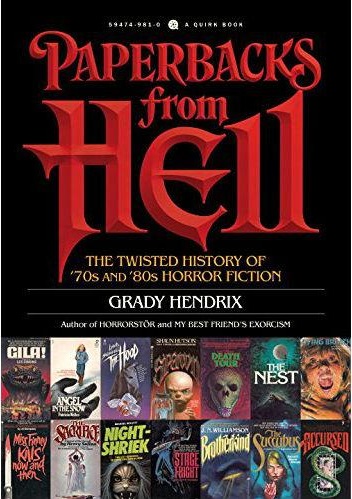Book Review: Paperbacks from Hell by Grady Hendrix
Back in the 1970s and 1980s, there was a big boom in paperback horror books, which was helped along by some truly lurid cover art that told the potential reader right up front that this was a book about, say, flesh-eating rabbits. Horror writer and vintage paperback collector Grady Hendrix leads us on a voyage through these exciting decades.

After an introduction in which Mr. Hendrix talks about his discovery of “The Little People” by John Christopher, which includes Nazi leprechauns as a major plot point, and got him interested in what else might be out there, the book takes us on a journey from Satan through haunted houses to serial killers.
Per this history, horror book covers in the 1960s tended towards the understated and even the downright musty. Horror was a smaller part of the market, and the majority of the novels coming out were old-fashioned. But gothic romance was the hot thing, and the classic “woman in nightgown running from castle with one lit window” covers gave them a clear identity.
About the time gothic romance was giving way in popularity to “bodice-rippers”, Rosemary’s Baby, The Other, and The Exorcist all came out right in a row. They hit the bestseller lists, and suddenly horror literature was hot!
But eventually market changes ripped the heart out of the midlist publishers, and the emphasis was on books that were “guaranteed” to sell for three months. “Thrillers” rather than “chillers” dominated the bestseller list. Oh, horror literature still survives, but it’s mostly small press these days, and covers often make you have to work to determine if a book is horror or just urban fantasy.
Of course, this sort of history just wouldn’t look right without plenty of illustrations, and full-color ones at that. This book delivers with many cover reproductions, including both pages of several die-cut covers. (That is, where the outside cover has a hole in it that reveals part of the inside cover.)
Naturally, there are some gruesome images that might not be suitable for sensitive readers. The “Inhumanoids” chapter also points out that there was a subsection of the genre that heavily played on fear of non-white people and “foreign” cultures; Native American lore was especially mined for horrors.
End matter includes minibios of some of the creators and publishers discussed, recommendations of the books that are actually fun to read, extensive picture credits, acknowledgements, and an index.
The writing style is humorous, but more in the way of setting up one-liners rather than horror host puns. “If Whitney Houston is right, and the children are indeed our future, then we need to approach our future with maximum caution.”
While this book may be fun to get for yourself, it would also make a fine gift for your horror-obsessed relative or friend. It’s sure to spark many a discussion if you let the neighbors see it!

